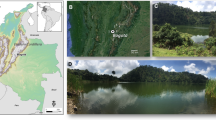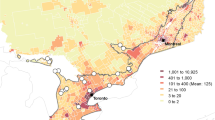Abstract
The natural eutrophication of lakes is still an accepted concept in limnology, arising as it does from the earliest efforts to classify lakes and place them in an evolutionary sequence. Recent studies of newly formed lakes at Glacier Bay, Alaska, only partially support this idea, and suggest more variable trends in lake trophic development which are under local (catchment-level) control. Here we use sediment cores from several lakes in Glacier Bay National Park to examine the relationship between successional changes in catchment vegetation and trends in water-column nitrogen (a limiting nutrient) and lake primary production. Terrestrial succession at Glacier Bay follows several different pathways, with older sites in the lower bay being colonized directly by spruce (Picea) and by-passing a prolonged alder (Alnus) stage that characterizes younger upper-bay sites. Sediment cores from three sites spanning this successional gradient demonstrate that the variability in nitrogen trends among lakes is a consequence of the establishment and duration of N-fixing alder in the lake catchment. In the lower-bay lakes, diatom-inferred nitrogen concentrations rise and then fall in concert with the transient appearance of alder in the catchment, while in the upper bay, high nitrogen concentrations are sustained by the continuous dominance of alder. Diatom accumulation, a proxy for whole-lake biological productivity, increases steadily at all three sites during the first century following lake formation, but declines in more recent times at the lower-bay sites in apparent response to the disappearance of alder and decreasing lake-water nitrogen. These results demonstrate a tight biogeochemical coupling between terrestrial succession and lake trophic change during the early developmental history of Glacier Bay lakes.
Similar content being viewed by others
References
P.G. Appleby (2001) Chronostratigraphic techniques in recent sediments W.M. Last J.P. Smol (Eds) Tracking Environmental Change Using Lake Sediments. Volume 1: Basin Analysis, Coring, and Chronological Techniques Kluwer Academic Publishers Dordrecht 171–203
R.W. Battarbee V.J. Jones R.J. Flower N.G. Cameron H. Bennion L. Carvalho S. Juggins (2001) Diatoms J.P. Smol H.J.B. Birks W.M. Last (Eds) Tracking Environmental Change Using Lake Sediments Volume. 3: Terrestrial, Algal, and Siliceous Indicators Kluwer Dordrecht 155–202
M.W. Binford E.S. Deevey (1983) ArticleTitlePaleolimnology: an historical perspective on lacustrine ecosystems Ann. Rev. Ecol. Syst. 14 255–286 Occurrence Handle10.1146/annurev.es.14.110183.001351
B.T. Bormann R.C. Sidle (1990) ArticleTitleChanges in productivity and distribution of nutrients in a chronosequence at Glacier Bay National Park, Alaska J. Ecol. 78 561–578 Occurrence Handle10.2307/2260884
W.S. Cooper (1923) ArticleTitleThe recent ecological history of Glacier Bay, Alaska: II. The present vegetation cycle Ecology 4 223–246 Occurrence Handle10.2307/1929047
R.L. Crocker J. Major (1955) ArticleTitleSoil development in relation to vegetation and surface age at Glacier Bay, Alaska J. Ecol. 43 427–448 Occurrence Handle10.2307/2257005
E.S. Deevey (1942) ArticleTitleStudies on Connecticut Lake sediments. III. The biostratonomy of Linsley Pond Am. J. Sci. 240 313–324 Occurrence Handle10.2475/ajs.240.5.313
D.R. Engstrom S.C. Fritz J.E. Almendinger S. Juggins (2000) ArticleTitleChemical and biological trends during lake evolution in recently deglaciated terrain Nature 408 161–166 Occurrence Handle1:CAS:528:DC%2BD3cXotFChsr8%3D Occurrence Handle10.1038/35041500
K. Fægri J. Iversen (1989) Textbook of Pollen Analysis Wiley New York 328
C.L. Fastie (1995) ArticleTitleCauses and ecosystem consequences of multiple successional pathways of primary succession at Glacier Bay, Alaska Ecology 76 1899–1916 Occurrence Handle10.2307/1940722
M.S. Ford (1990) ArticleTitleA 10,000-yr history of natural ecosystem acidification Ecol. Monogr. 60 57–89 Occurrence Handle10.2307/1943026
S.C. Fritz D.R. Engstrom S. Juggins (2004) ArticleTitlePatterns of early lake evolution in boreal landscapes: a comparison of stratigraphic inferences with a modern chronosequence in Glacier Bay, Alaska Holocene 14 828–840 Occurrence Handle10.1191/0959683604hl763rp
O. Heiri A.F. Lotter G. Lemcke (2001) ArticleTitleLoss on ignition as a method for estimating organic and carbonate content in sediments: reproducibility and comparability of results J. Paleolimnol. 25 101–110 Occurrence Handle10.1023/A:1008119611481
F.S. Hu B.P. Finney L.B. Brubaker (2001) ArticleTitleEffects of Holocene Alnus expansion on aquatic productivity, nitrogen cycling, and soil development in southwestern Alaska Ecosystems 4 358–368 Occurrence Handle1:CAS:528:DC%2BD3MXltlKjsbw%3D Occurrence Handle10.1007/s10021-001-0017-0
P. Huttunen J. Meriläinen K. Tolonen (1978) ArticleTitleThe history of a small dystrophied forest lake, southern Finland Pol. Arch. Hydrobiol. 25 189–202 Occurrence Handle1:CAS:528:DyaE1cXls1yktL4%3D
D.B. Lawrence (1958) ArticleTitleGlaciers and vegetation in southeastern Alaska Am. Scient. 46 89–122
E. Naumann (1932) ArticleTitleGrundzuge der regionalen limnologie Die Binnengewasser 11 1–176
Olson O.G. 1998. Mechanisms controlling long-term changes in periphytic diatom community structure, Ph.D. Thesis, Lehigh University, 112 pp.
W.H. Pearsall (1921) ArticleTitleThe development of vegetation in the English Lakes, considered in relation to the general evolution of glacial lakes and rock basins Proc. R. Soc. B 92 259–284 Occurrence Handle10.1098/rspb.1921.0024 Occurrence Handle1:CAS:528:DyaB38XitVGhsQ%3D%3D
W. Pennington E.Y. Haworth A.P. Bonny J.P. Lishman (1972) ArticleTitleLake sediments in northern Scotland Phil. Trans. R. Soc. B 264 191–294
W.A. Reiners I.A. Worley D.B. Lawrence (1971) ArticleTitlePlant diversity in a chronosequence at Glacier Bay, Alaska Ecology 52 55–69 Occurrence Handle10.2307/1934737
I. Renberg (1986) A sedimentary diatom record of severe acidification in Lake Blamissusjön, N. Sweden, through natural soil processes J.P. Smol R.W. Battarbee J. Meriläinen (Eds) Diatoms and Lake Acidity Dr W. Junk Publishers Dordrecht 213–219
F.E. Round (1961) ArticleTitleThe diatoms of a core from Esthwaite Water New Phytol. 60 43–59 Occurrence Handle10.1111/j.1469-8137.1961.tb06238.x
C.J.F. ter Braak (1986) ArticleTitleCanonical correspondence analysis: a new eigenvector method for multivariate direct gradient analysis Ecology 67 1167–1179 Occurrence Handle10.2307/1938672
A. Thienemann (1931) ArticleTitleTropische seen und seetyplehre Arch. Hydrobiol. 9 205–231
D.R. Whitehead D.F. Charles S.T. Jackson J.P. Smol D.R. Engstrom (1989) ArticleTitleThe developmental history of Adirondack (N.Y.) lakes J. Paleolimnol. 2 185–206 Occurrence Handle10.1007/BF00202046
Author information
Authors and Affiliations
Corresponding author
Rights and permissions
About this article
Cite this article
Engstrom, D.R., Fritz, S.C. Coupling between Primary Terrestrial Succession and the Trophic Development of Lakes at Glacier Bay, Alaska. J Paleolimnol 35, 873–880 (2006). https://doi.org/10.1007/s10933-005-5858-7
Received:
Accepted:
Issue Date:
DOI: https://doi.org/10.1007/s10933-005-5858-7




